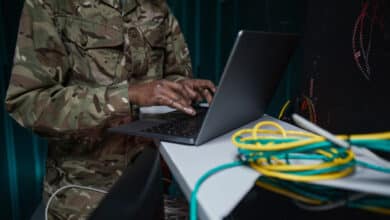
OpenAI’s ChatGPT marks a turning point in the development of artificial intelligence (AI). As one of the most advanced language models, it revolutionizes the interaction between humans and machines. This technology is not only influencing the way we search and process information, but also the way we communicate with computers in general. Although ChatGPT often takes center stage, there are numerous similar models that highlight the advances in AI research. To understand the technology behind ChatGPT, we look at the technical foundations that make such language models possible. The focus is on how they work, the principle of machine learning and the associated challenges in developing such technologies.
Understanding the technology behind ChatGPT: The basics of AI and machine learning
To understand how ChatGPT and similar technologies work, it’s important to clarify two fundamental concepts: artificial intelligence (AI) and machine learning (ML). You’ve almost certainly heard of these terms before, but what exactly do they mean?
What exactly is artificial intelligence (AI)?
Artificial intelligence falls within the field of computer science, which aims to create machines that can perform tasks that would normally require human intelligence. This includes a wide range of capabilities such as understanding language, recognizing images, problem solving and learning from experience. AI can be divided into two main types: weak AI, which is designed for specific tasks, and strong AI, which has a broader understanding and adaptability, similar to human intelligence.
The key to this is machine learning (ML)
Machine learning is a subfield of AI that focuses on giving computers the ability to learn and improve from data without having to be explicitly programmed. By analyzing patterns in data, ML models can make predictions or decisions based on new, never-before-seen data. Understanding the technology behind ChatGPT means recognizing that machine learning is at the heart of this and many other modern AI systems.
From codes to data: Understanding the transition to the technology behind ChatGPT
The core difference between traditional programming and machine learning lies in the approach to the problem. In traditional programming, a developer writes code that contains specific instructions to solve a task. The computer then follows these instructions when it encounters the relevant data.
Machine learning, on the other hand, reverses this process. Instead of directly programming the computer to solve a task, it is fed with large amounts of data and the corresponding results. The computer then learns from this data by identifying patterns and relationships and develops a model that can make predictions about new data. This ability to self-improve and adapt to new situations without direct human input is what makes machine learning so powerful and challenging at the same time.
What are language models actually?
Language models are at the heart of the interaction between humans and machines in the world of artificial intelligence (AI), especially in the field of natural language processing, also known as neuro-linguistic programming – NLP for short. They enable computers to understand and generate human language, which is the basis for many of today’s technologies, from virtual assistants to automatic translation systems.
Natural Language Processing (NLP): A fundamental concept to understand the technology behind ChatGPT
Natural language processing enables machines to interpret and process text and speech in the same way that humans do. This ranges from understanding spoken words to recognizing and applying the complex rules that underlie our language. NLP uses language models to accomplish tasks such as translating text, answering questions and even creating new content.
The diversity of language models
Language models come in different forms, each with their own approach to capturing and interpreting the complexity of human language:
- Statistical language models are among the pioneers of natural language processing technologies. They are based on the statistical analysis of text data to calculate the probability of certain words or word sequences occurring in a given context. By recognizing patterns in the use of language, these models can predict which words are likely to come next based on the previous words in a sentence. This method enabled early models to perform simple text tasks such as text completion or correction with a certain degree of accuracy.
- Neural network models such as LSTM (Long Short-Term Memory) and GRU (Gated Recurrent Unit) have significantly improved the ability to retain and understand context across longer passages of text. These models overcome challenges of traditional approaches by effectively processing information over longer periods of time. Their sophisticated structure allows previous data to be remembered and context to be better interpreted in large textual data. This makes them particularly valuable for tasks such as translating complex texts or answering questions based on extended textual contexts. LSTMs and GRUs provide powerful tools for language processing and open up new possibilities in artificial intelligence.
- Transformer-based models, including BERT (Bidirectional Encoder Representations from Transformers) and GPT (Generative Pre-trained Transformer), are setting new standards in language understanding and generation. These models use sophisticated learning mechanisms to develop a comprehensive understanding of language structures.
An indispensable component of modern technologies
The use of language models spans numerous applications, from improving customer service through more efficient chatbots to assisting in the analysis and interpretation of large amounts of data. Their development and refinement are driving innovation by enabling seamless and intuitive interaction between humans and machines.
Understanding the architecture – the technology behind ChatGPT
A thorough understanding of ChatGPT’s architecture requires an insight into the technologies that enable its impressive performance. At the center of this is the Transformer architecture, which is specifically designed for processing sequential data.
Technical overview: Transformer at the core
Transformer models are characterized by their ability to recognize far-reaching dependencies in data. The key to this is the self-attention mechanism, which enables the meaning of each word to be weighted in the context of the entire text.
Training ChatGPT: a multi-stage process
The process of training a powerful model like ChatGPT starts long before the actual training begins. Careful preparation of the data is crucial to the success of the training process.
Data preparation
Before ChatGPT or similar models can begin learning, an extensive collection of data must be compiled and prepared. The selection of training data is crucial, as it lays the foundation for the understanding and diversity of the model. Not only must this data cover a wide range of language styles and topics, but it must also be prepared in such a way that it can be used efficiently by the model. This includes cleaning the data from noise and normalizing texts to create a consistent basis for training.
After this thorough preparation, the data is ready for the training process, in which the model is prepared to capture the complexity of human language and generate comprehensible texts.
Understanding how ChatGPT works: Insights into the driving technology
ChatGPT and other advanced language models are designed to understand, generate and respond to text based on previous interactions. To understand the technology behind ChatGPT, it is essential to consider its ability to process complex requests through contextual understanding and “memory”. These capabilities enable improved communication and interaction with users.
How ChatGPT processes requests
When ChatGPT receives a request, it goes through several steps of processing:
- First, the text is broken down into smaller units called tokens. These tokens can be words or parts of words that allow the model to analyze the structure of the request.
- Using the transformer architecture, ChatGPT evaluates the context of each token in relation to the others. This allows the model to understand the meaning of the request in its entirety.
- Based on this context, ChatGPT generates a response. It selects the next token sequence with the highest probability to provide a meaningful continuation of the input.
Application of context understanding and memory
ChatGPT’s ability to utilize context and memory sets it apart from simpler models:
- ChatGPT can retain the context of a conversation across multiple requests. This means that it is able to draw on information from previous messages in the conversation to provide substantive and relevant answers.
- Although memory in AI systems is not equivalent to human memory, ChatGPT has mechanisms that allow it to “remember” relevant information from the current dialog. This is achieved by maintaining an internal state. This allows the model to take into account the relationship between different parts of the conversation.
Examples
A practical example of ChatGPT’s contextual understanding and memory could be a conversation about a specific topic, such as planning a trip. ChatGPT can remember details such as the user’s desired destination, dates and preferences mentioned at the beginning of the conversation across multiple messages and integrate them into its responses. This capability allows for a more natural and helpful interaction than if each response was generated in isolation. This results in a more fluid dialog, even if there are still some weak points.
Training data and learning process – understanding the technology behind ChatGPT
ChatGPT’s ability to process and respond to complex requests is, as already mentioned, based on extensive training data and a sophisticated learning process. These components are critical to developing a model that not only understands language, but is also able to interact in a way that mirrors how humans interact with language.
Scope and sources of training data
ChatGPT has been trained with an extensive arsenal of textual data, spanning a wide range of sources. These include books, websites, news articles and other publicly available texts. This diversity is crucial in providing the model with a comprehensive understanding of different language styles, dialects and contexts. By training with data from a variety of contexts, the model learns to respond flexibly to a wide range of queries.
Reinforcement Learning from Human Feedback (RLHF)
A key aspect of the ChatGPT training process is reinforcement learning from human feedback– RLHF for short. This process aims to improve the performance of the model through direct human feedback.
- First, the model is trained using a process called supervised fine-tuning. In this process, the model is shown examples that contain both questions and the appropriate answers. These examples are created by humans to teach the model specific answers.
- Humans then evaluate the answers generated by the model to create a reward model. This model learns which answers are considered high quality based on human judgment.
- Finally, the model is trained further using the reward model. Through this process, it learns to generate answers that are rated higher, resulting in improved quality and relevance of the generated texts. This process is called reinforcement learning.
RLHF is particularly important as it allows ChatGPT to capture more subtle aspects of human communication, such as the ability to provide nuanced responses that take into account the tone and context of the request. Through this approach, RLHF helps to continuously improve the model’s performance. It learns directly from user preferences and ratings.
Challenges in understanding the technology behind ChatGPT
Although ChatGPT and similar language models perform impressively in many areas, they face significant challenges and limitations, both technical and ethical.
Limitations of ChatGPT
A key problem is the presence of biases and errors in the training data. This data comes from a wide range of sources and often reflects the inequalities and biases that exist in society. As a result, ChatGPT can unintentionally generate discriminatory or inaccurate responses. There is also the challenge of correctly understanding and processing complex queries, especially when the model is confronted with new or unexpected topics.
The model’s ability to retain context over longer conversations is limited. Although it demonstrates deep linguistic understanding, it may have difficulty grasping and consistently incorporating all relevant details. This impairs their ability to respond appropriately in certain situations.
Ethics and privacy
The generation of content by AI raises important questions. How do we deal with copyright, authenticity and the trustworthiness of AI-generated texts? It is crucial that users are able to understand and evaluate the sources and credibility of the information they receive.
In addition, data privacy is a critical issue when using data to train AI models. It must be ensured that no personal or sensitive information is misused and that the privacy of individuals remains protected.
Future prospects – understanding and shaping the technology behind ChatGPT
A basic understanding of the technology behind ChatGPT reveals its potential to significantly shape future social and technological developments. OpenAI and other organizations are continuing their work to further improve the performance, accuracy and ethical alignment of these models.
Improvement initiatives
A key focus is on reducing bias and error in the models’ responses. Through refined training methods and more diversified data collection, research teams aim to increase the neutrality and fairness of AI-generated content. Advanced techniques are also being developed to improve the understanding and generation of complex human communication. In short, with the introduction of new models, the boundaries of what AI can do in natural language processing are expected to be pushed further.
Areas of application of AI in practice
The future applications of language models are diverse and promising, as AI is already being used extensively. These models have the potential to revolutionize numerous areas, such as:
- In education, they could enable personalized learning experiences by catering to the needs of individual students.
- In healthcare, they could support diagnosis and patient care by making medical expertise more accessible.
- In customer care, advanced chatbots could lead to more efficient and satisfying interactions.
- In addition, language models could open up new creative possibilities in the creation of content, from journalistic articles to literature.
In addition, countless other scenarios are conceivable that could find even broader application through the further development of language models and AI technologies.
Understanding technology and shaping society with the insights behind ChatGPT
The advancement and proliferation of language models will undoubtedly have a fundamental impact on society. It will change the way we interact with technology. AI promises a world where communication between humans and machines is seamless and intuitive, breaking down barriers and enabling new forms of collaboration. At the same time, it is important to carefully consider the ethical issues surrounding these developments. In particular, questions around data protection, changes in the workplace and accountability for AI-generated content need to be seriously considered.
The potential of ChatGPT: a technical milestone
ChatGPT marks a significant advance in the development of artificial intelligence, fundamentally changing the interaction between humans and technology. As a sophisticated language model, it has not only improved our ability to communicate with machines in a natural and intuitive way, but also opened the doors to new fields of application in various industries. The technology behind ChatGPT sheds light on AI’s potential future ability to solve complex problems and enrich everyday life. At the same time, however, it also raises ethical and practical challenges that need to be considered now. The ongoing development and integration of AI into our daily lives promises exciting innovations, but also requires careful reflection on how to deal with the associated risks and opportunities.



